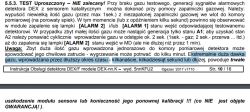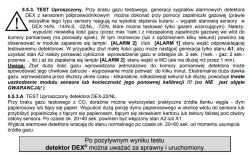piracik wrote:Domelski wrote:
You can see that a colleague "specialist" works in the topic (> 2000 posts) and wrote that he checks.
I can see my friend that you are very fond of me.
Buddy "Piracik" by the way, I have no bad intentions.
I already wrote that I did not know that the signature "specialist" is automatically suitable. I thought that you added it yourself, which would indicate high knowledge, and thus respect for your advice among users.
This is important because if someone sees that a "specialist" writes something, they consider it to be true.
I am not trying to attack anyone here, but I refer to posts because as you can see there is some interest in the topic.
piracik wrote:Nowhere did I write that I perform tests under protocols.
I don't calibrate the detectors and check them as you do as part of their inspections.
I also do not have the signature of a specialist detectors, only heating systems, and these are probably two different fields.
buddy you wrote:
piracik wrote:I check them all with a lighter. I fire it up, blow it out and put it on for a while. Everyone should start screaming!
I have known both industries for a long time and I know how boiler service technicians try to check detectors.
On the one hand, you write that you check "all", and in a moment you write that you do not check anything for protocols, etc.
Don't judge me. You write that you do not check anything under the protocols and ok I believe you.
I just hope that after a few of my posts you will take a broader look at these devices and will not make a dangerous mistake in the future. You gave dangerous advice on the forum and forgive me, but I reacted.
piracik wrote:I only wrote how I check if the entire system, e.g. gazex, works. Whether the detector responds to gas, an alarm occurs and the valve closes. So I check for myself.
What for?
For the first time I hear that I am servicing a device (e.g. a boiler), but I will do a few more works for myself, for which the client will not pay me.
But okay, I believe you. I suggest we don't go further with this.
piracik wrote:I am not interested in the exact activation concentration because this measurement and calibration is within the scope of the service. Detectors are shipped every 2 years.
Dude, you're really embarrassing yourself.
1. According to the manual, the detection system should be serviced every 3 months. (for Gazex systems)
You can read more about periods here: http://detektory.pl/index.php?k=serwisdetekcja
2. Calibration of sensors (depending on the type, it is performed every 6, 12 or 36 months). There are no (periodic) ones every 2 years.
DEX (GAZEX) instruction page 4:
Semiconductor: https://www.gazex.pl/media/pdfs/docs/dex-nn-n/u1-4/ins_DEXnn_4F4CnnN_1710.pdf
Catalytic: https://www.gazex.pl/media/pdfs/docs/dex-nn-k/u2-2/ins_DEXnnK_vU2_5nnKFU2_1710.pdf
3. Calibration of the sensor module itself is not a confirmation of technical inspection and in no way replaces it.
So you do customer reviews with a lighter, and if something doesn't workor the system requires calibration, which as an unauthorized service you cannot do, you send the sensor to the service and you think that the system is properly serviced by giving such advice on the forum.
In addition, the detector is shipped on a date not provided for in any instructions.
Sorry, but you write it yourself and you claim that you do not issue a report of these activities. I'm really not helping you with this and I really want to believe.
I suggest we go no further.
piracik wrote:Domelski wrote:
In addition, exceeding the range can cause decalibration or even damage to the detector.
You got me a little confused here.
I had the detector calibrated about two months ago. I had a pretty serious gas leak last week. The detector got 100% of the dose.
!!! ATTENTION !!!
1. How do you know more than 100% of the dose. Unfortunately, you use unprofessional terms (no offense) and I have a hard time understanding what you mean. Whether it is 100% LEL or 100% v/v.
2. Exceeding 100% LEL in the boiler room is a huge risk of explosion. And the boiler room is still standing?
3. Since the detector was calibrated and the system reacted correctly, the valve worked at 30% LEL (probably because I don't know how it was set, and this setting is the most common). The rest of the gas leaving the pipeline is small and should not create a concentration of 100% LEL. If it did, the designer has designed the facility incorrectly and you should find out on the site that the pipeline contains a huge amount of gas and there should be more valves than just the main one to break the pipeline into pieces.
You have gas rights.
Buddy, if there was a case of reaching 100% LEL on the facility, then you were one step away from a disaster.
piracik wrote:Do I need to recalibrate it? How to avoid such situations in the future?
Any detector that has been in an atmosphere outside its measuring range must be calibrated because you never know what condition it is in. Of course, it depends on the exposure time, the height of the crossing, etc. Some sensors are more resistant than others. And the IR sensors are completely resistant (no chemical reaction takes place in them).
piracik wrote:Are smaller doses of such gas safe for the detector or can they also decalibrate or damage it?
Unfortunately, all sensors except infrared (IR) are based on chemical-physical reactions. This means that contact with the gas is a consumable factor for the detector. That is why manufacturers recommend technical inspections and why they are not done with a lighter. The point is to check the condition of the detector during the inspection. And for this, it is necessary to supply gases with specific parameters (matched to a given detector).
What you are asking about, i.e. detectors working in the so-called gas background (in an atmosphere containing small amounts of gas) decalibrate very quickly. Therefore, their calibration has nothing to do with periodic calibration. Periodic calibration is given for detectors operating in a clean atmosphere. That is, if e.g. The manufacturer stated that in a clean atmosphere, the detector is calibrated every 3 years. If you have a gas background, very often the detector is significantly decalibrated after 0.5 year (sometimes after 1 year - you never know). If the inspection is done with a cigarette lighter, you will never catch such an error and the detector will not work properly in an emergency.
To illustrate the problem in portable meters, manufacturers recommend calibration before each measurement.
The atmosphere in the facilities is never 100% clean. There are different kinds of garbage in it and the working conditions of the devices are different. That is why frequent inspections using the right equipment are so important and cannot be skipped or performed with the wrong equipment.




